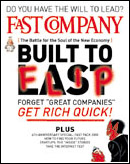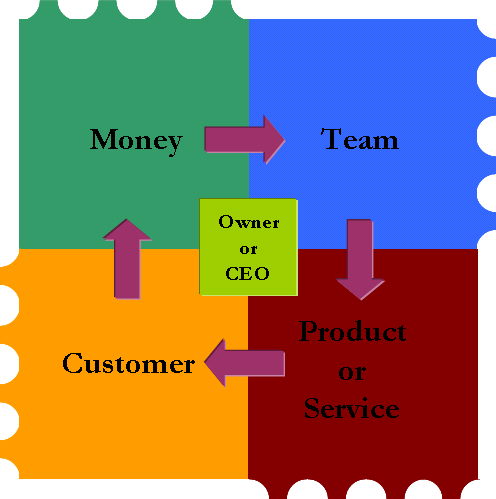… You want to raise just enough money to solve a small problem for even a smaller set of customers to start with.
A lot of ventures start with a dream, a vision; to solve a problem in a specific  way. The dream could be a INR 100 crore product or something as complex as an ERP on the web to a even more complicated, a Hospital Information Systems (.. search engines? they are easier to build these days).
way. The dream could be a INR 100 crore product or something as complex as an ERP on the web to a even more complicated, a Hospital Information Systems (.. search engines? they are easier to build these days).
The vision cannot be achieved in 6 months or even 2 years — Takes 5-7 years on an average to build an INR 100 crore company. So you want to start now, and want to start small, chiseling your idea, refining as you go, adding feathers in your cap and changing gears and accelerating as you move.
First, zero in on a handful of customers and a specific problem the customer may have. Do not worry if others mock you for building a feature & not a product. You know your destiny. You know where you want to reach. Validate what you have built. Give the customer something useful so that he can pay for what you have built. Iterate on your product.
There are a lot of examples where the companies started small and began by solving just one small problem and then morphed into gorillas; from companies selling PCs — to cloth merchants now with fully backward integrated perto-products chain.
A large amount of money spoils you, ties you up with your own experiments and forces you to deliver a product which does not have any takers outside your laboratory — You are forced to linger with the experiment because now you have a large amount of an external investor’s money and do not have guts to tell him that it is not working out. There are numerous examples. There are only a few brave entrepreneurs who took $5m only to tell the board in less than a month about change in the business model.
When you are starting out, you are building something and proving your hypothesis. The moment someone starts paying for what you are building, a part of the hypothesis gets proved. You continue to iterate.
Think 6 months, 3 people’s expenses.
Think 6 months, 2 people’s expenses.
Think the amount of first tranche you need to deliver to your first customer.
Think about knowing the sales process yourself before hiring a sales expert.
Think doing zero dollar marketing before doing SEM campaigns.
Think writing the code yourself before hiring a developer.
… start thinking about raising big money after your customer trusts you with his money.
(The thumbnail is of a Ruby-throated hummingbird. These are solitary. Have one of the highest metabolism, and as part of their migration, they fly non-stop across the Gulf of Mexico, a distance of at least 500 miles. Pic courtesy)

 Unless you write a manuscript and revise it multiple times and get rejected by at least 5 publishers–how can you write one of India’s best-selling book? Unless 20 VCs label your ideas as stupid, how can the 21st get it funded?
Unless you write a manuscript and revise it multiple times and get rejected by at least 5 publishers–how can you write one of India’s best-selling book? Unless 20 VCs label your ideas as stupid, how can the 21st get it funded? I was reading an interesting
I was reading an interesting  The chart shows four tangible entities which are the main constituents of a business. Each constituent is in it’s own quadrant.The inbound arrow depicts movement or utilization of a resource. As owner/CEO, you create the business. The Team which you hire creates the product or service. This is consumed by a Customer which brings Money to the business. The Money in turn funds the Team. If the Team is weak or inefficient it would impact the product or service. Even more, an incompetent team may consume the money unwisely thus hampering the overall cycle of the business. Though the business revolves around the presence of the Owner/Founder/CEO, the continuum of the business is maintained by the efficiency of the team.
The chart shows four tangible entities which are the main constituents of a business. Each constituent is in it’s own quadrant.The inbound arrow depicts movement or utilization of a resource. As owner/CEO, you create the business. The Team which you hire creates the product or service. This is consumed by a Customer which brings Money to the business. The Money in turn funds the Team. If the Team is weak or inefficient it would impact the product or service. Even more, an incompetent team may consume the money unwisely thus hampering the overall cycle of the business. Though the business revolves around the presence of the Owner/Founder/CEO, the continuum of the business is maintained by the efficiency of the team. out wherever/whenever possible and making an ass out of myself at other times. From participating in mindless discussions to taking split-second leadership roles; to managing wherever required and at times staying out of the loop sipping beer at the poolside … and of course flirting occasionally (Don’t worry, my better half never reads this blog).
out wherever/whenever possible and making an ass out of myself at other times. From participating in mindless discussions to taking split-second leadership roles; to managing wherever required and at times staying out of the loop sipping beer at the poolside … and of course flirting occasionally (Don’t worry, my better half never reads this blog). way. The dream could be a INR 100 crore product or something as complex as an ERP on the web to a even more complicated, a Hospital Information Systems (.. search engines? they are easier to build these days).
way. The dream could be a INR 100 crore product or something as complex as an ERP on the web to a even more complicated, a Hospital Information Systems (.. search engines? they are easier to build these days). As a Founder, CEO, whatever of the startup — one thing you would be doing in your journey would be
As a Founder, CEO, whatever of the startup — one thing you would be doing in your journey would be